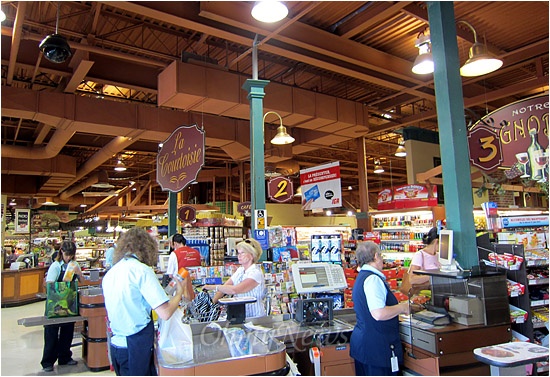List
Story > NEWS > Detail
[News] Regional Economic Development Project in Quebec, Canada
The Quebec case shows a flexible and active response strategy of co-operatives and social economies that meet the changes and needs of cities and regions. It has already been proven by Quebec's history that their self-reliance capabilities in solving crises and problems facing the community from a sustainable and integrated perspective were never created in a short period of time. As the period of the "quiet revolution" has passed, the ethnic and cultural identity unique to the French-speaking people of Quebec has been enhanced in density, and its identity has become the power to create their own community solutions to cities and regions.

<The Young People Who Lead Urban Regeneration in Quebec>
Since the 1980s, Quebec has sought to co-exist with the community and improve the quality of life for local residents by developing alternative areas led by residents through co-operatives and social economies in various areas of urban and rural areas. The CED (Community Economic Development) project was based on a sustainable and integrated perspective. The government intended to promote economic, social, ecological and cultural development of the community by strengthening economic opportunities and social conditions in the region. Because he believed that unemployment, poverty, jobless growth, environmental pollution, and uncontrollable situations facing the community could be solved through an integrated and participatory approach centered on grass roots, he agonized over the economic activities of the residents and considered residential and community services at the same time.
Rather than fighting the government, Quebec's labor movement, which has been mired in widespread unemployment in the 1980s, moves toward creating its own jobs by setting up a labor movement-led fund in 1983 with tax breaks in negotiations with the federal and state governments. Under these conditions, civil society-based community activists establish the Community Development Corporation (CEDCs) in underdeveloped areas of Montreal. CEDCs formed an active partnership with internal enterprises and labor movements, co-operatives, social enterprises, social movements, and social movements in the community, and became a framework for self-reliance activities from below by local residents, and later became an important asset in the formation of the unique network of the Quebec area called Chantiera.

The southwestern region of Montreal, once the most prosperous along the Racine Canal, has been reduced to a backward region with the closure of the canal, where civil society activists, who were active around the community, will set up a new framework for community movements through the establishment of CEDCs in 1989. RESO is the first CEDCs established in Quebec, and 13 CEDCs were once established in Quebec, but is now closing or being converted into a start-up support center (PME) due to the suspension of state financial support. Through the successful experience of CEDCs for community regeneration, the Quebec government in 1998 established the Community Center (CLD); the Local Development Center (LOCD); about 120 CLDs were active. If the CEDCs were mainly active in decaying urban areas, the CDR (Cooperative de Development Cooperative) was relatively a major target area for urban areas or rural areas. The CDR was established in 1986 under the initiative of the government to support the establishment and activation of cooperative associations in rural areas. In 1982 the Canadian government abolished the DREE (Det. of Regional Economic Expansion) in the 1960s and 1970s after its policy of moving populations for community development failed, shifting existing top-down policies to partner-style, and changing the role of government from indicator to facilitator or enabler. This shift in policy stance was made in the 1980s by the government to support the establishment and activation of cooperatives in rural areas. The CDR was established under the initiative.

In 1998, 10 CDRs formed the Federation (FCDR) across the state, and in 1999 11 CDRs joined the association. As of 2013, the association's total sales stood at $5.8 million and its total assets at around $6.1 million. The FCDR consists of 11 cooperative networks covering 17 administrative districts in Quebec. By encompassing all sectoral co-operatives operating in the area, it becomes a reference in the establishment, development and representative functions of the co-operatives in each region. As of 2013, the CDR Network had a total of 1,175 co-operatives, indicating that more than half of the approximately 2,800 cooperatives in Quebec are subscribed to the CDR. Since its establishment, more than 1,400 co-operatives have been created over 15 years through support from the CDR, and more than 11,000 jobs have been created. In 2013 alone, it supported the establishment of 89 new co-operatives, creating 186 jobs. The CDR Network complements the activities of the league bodies by sector, which number 13 as of 2013, including agro-fisheries, food, housing, finance and mutual insurance, forest, funeral services, stationery supplies, home care, workers, workers' shareholders and Nubo Quebec Co-operatives.
The three main objectives of the CDR are to support the establishment of the initial cooperative of start-up, to unite the co-operatives so that cooperation between the co-operatives can be achieved, and to represent and promote the co-operatives within the three regions. Support for the establishment of co-operatives in the early days of startup is the most important activity of the CDR. The CDR employs experts in charge of establishing co-operatives who have knowledge of co-operatives' laws, principles and values and understand the collective dynamics and needs of entrepreneurs to support the new co-operatives to take the various steps necessary to establish them. The CDR also focuses on solidarity among co-operatives so that cooperatives can work together to achieve common goals. If the existing inter-cooperative solidarity and association were at the level of the industry-specific and sector-specific unions, the CDR-oriented inter-cooperative solidarity and association can be said to be meaningful in terms of regional-level solidarity and union. The CDR also plays a role in representing and promoting regional co-operatives in Shangtai and other major socio-economic meetings.

<Photo Source: OhmyNews>
The CDR converges the development resources of the community, provides cooperative operations and training programs, and organizes communication programs to communicate with the community. Connect the local press and various co-operatives together, establish business strategies at the local level through business consulting, and support each local cooperative group to ensure that realistic elements of the cooperative law are fully considered. It also supports the curriculum to learn the values and principles of co-operatives in regular classes at schools. Connect members, provide the information needed to run cooperative businesses, and create sustainable jobs and businesses within the region.
The Quebec case shows a flexible and active response strategy of co-operatives and social economies that meet the changes and needs of cities and regions. It has already been proven by Quebec's history that their self-reliance capabilities in solving crises and problems facing the community from a sustainable and integrated perspective were never created in a short period of time. As the period of the "quiet revolution" has passed, the ethnic and cultural identity unique to the French-speaking people of Quebec has been enhanced in density, and its identity has become the power to create their own community solutions to cities and regions.

<The Young People Who Lead Urban Regeneration in Quebec>
Since the 1980s, Quebec has sought to co-exist with the community and improve the quality of life for local residents by developing alternative areas led by residents through co-operatives and social economies in various areas of urban and rural areas. The CED (Community Economic Development) project was based on a sustainable and integrated perspective. The government intended to promote economic, social, ecological and cultural development of the community by strengthening economic opportunities and social conditions in the region. Because he believed that unemployment, poverty, jobless growth, environmental pollution, and uncontrollable situations facing the community could be solved through an integrated and participatory approach centered on grass roots, he agonized over the economic activities of the residents and considered residential and community services at the same time.
Rather than fighting the government, Quebec's labor movement, which has been mired in widespread unemployment in the 1980s, moves toward creating its own jobs by setting up a labor movement-led fund in 1983 with tax breaks in negotiations with the federal and state governments. Under these conditions, civil society-based community activists establish the Community Development Corporation (CEDCs) in underdeveloped areas of Montreal. CEDCs formed an active partnership with internal enterprises and labor movements, co-operatives, social enterprises, social movements, and social movements in the community, and became a framework for self-reliance activities from below by local residents, and later became an important asset in the formation of the unique network of the Quebec area called Chantiera.

The southwestern region of Montreal, once the most prosperous along the Racine Canal, has been reduced to a backward region with the closure of the canal, where civil society activists, who were active around the community, will set up a new framework for community movements through the establishment of CEDCs in 1989. RESO is the first CEDCs established in Quebec, and 13 CEDCs were once established in Quebec, but is now closing or being converted into a start-up support center (PME) due to the suspension of state financial support. Through the successful experience of CEDCs for community regeneration, the Quebec government in 1998 established the Community Center (CLD); the Local Development Center (LOCD); about 120 CLDs were active. If the CEDCs were mainly active in decaying urban areas, the CDR (Cooperative de Development Cooperative) was relatively a major target area for urban areas or rural areas. The CDR was established in 1986 under the initiative of the government to support the establishment and activation of cooperative associations in rural areas. In 1982 the Canadian government abolished the DREE (Det. of Regional Economic Expansion) in the 1960s and 1970s after its policy of moving populations for community development failed, shifting existing top-down policies to partner-style, and changing the role of government from indicator to facilitator or enabler. This shift in policy stance was made in the 1980s by the government to support the establishment and activation of cooperatives in rural areas. The CDR was established under the initiative.

In 1998, 10 CDRs formed the Federation (FCDR) across the state, and in 1999 11 CDRs joined the association. As of 2013, the association's total sales stood at $5.8 million and its total assets at around $6.1 million. The FCDR consists of 11 cooperative networks covering 17 administrative districts in Quebec. By encompassing all sectoral co-operatives operating in the area, it becomes a reference in the establishment, development and representative functions of the co-operatives in each region. As of 2013, the CDR Network had a total of 1,175 co-operatives, indicating that more than half of the approximately 2,800 cooperatives in Quebec are subscribed to the CDR. Since its establishment, more than 1,400 co-operatives have been created over 15 years through support from the CDR, and more than 11,000 jobs have been created. In 2013 alone, it supported the establishment of 89 new co-operatives, creating 186 jobs. The CDR Network complements the activities of the league bodies by sector, which number 13 as of 2013, including agro-fisheries, food, housing, finance and mutual insurance, forest, funeral services, stationery supplies, home care, workers, workers' shareholders and Nubo Quebec Co-operatives.
The three main objectives of the CDR are to support the establishment of the initial cooperative of start-up, to unite the co-operatives so that cooperation between the co-operatives can be achieved, and to represent and promote the co-operatives within the three regions. Support for the establishment of co-operatives in the early days of startup is the most important activity of the CDR. The CDR employs experts in charge of establishing co-operatives who have knowledge of co-operatives' laws, principles and values and understand the collective dynamics and needs of entrepreneurs to support the new co-operatives to take the various steps necessary to establish them. The CDR also focuses on solidarity among co-operatives so that cooperatives can work together to achieve common goals. If the existing inter-cooperative solidarity and association were at the level of the industry-specific and sector-specific unions, the CDR-oriented inter-cooperative solidarity and association can be said to be meaningful in terms of regional-level solidarity and union. The CDR also plays a role in representing and promoting regional co-operatives in Shangtai and other major socio-economic meetings.

<Photo Source: OhmyNews>
The CDR converges the development resources of the community, provides cooperative operations and training programs, and organizes communication programs to communicate with the community. Connect the local press and various co-operatives together, establish business strategies at the local level through business consulting, and support each local cooperative group to ensure that realistic elements of the cooperative law are fully considered. It also supports the curriculum to learn the values and principles of co-operatives in regular classes at schools. Connect members, provide the information needed to run cooperative businesses, and create sustainable jobs and businesses within the region.



